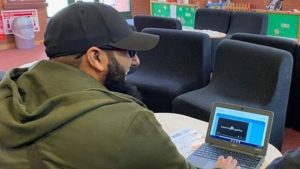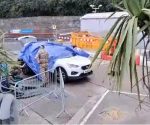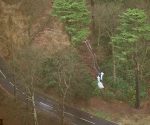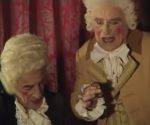First anonymous Andy is stabbed, then he isn’t; naturally, the Fishmongers’ Hall inquests stink already
Following the publication here at FBEL of some of the transcript from the review hearing of the Fishmongers’ Hall inquests , which will be investigating the deaths of three people in the supposed 29th November 2019 terror attack, Usman Khan and his two victims, Jack Merritt and Saskia Jones, what follows is a modest amount of analysis.
While the division of the coroners’ inquest into two is cast as being functionally advantageous for separating out focus specific to the events, it can be read as a device to minimise the emergence of information that casts doubt on Khan being the perpetrator of the attack. Naturally, or else such a statement would not be made, the good reason for this comprehension can be constructed from the evidence.
First of all, there is the inexplicable imprecision of the presiding official and Chief Coroner, a Mark Lucraft, who rightly allows for the apparent fact that Khan was set upon by by-standers within the hall, it is supposed, in reaction to his attack, but then gave the impression that a new set of have-a-go heroes – other than those who had already become involved inside the Hall – took on Khan outside the premises on London Bridge. We should note that if this story is incorrect, it would nevertheless suit the explanation that Lucraft proffers for Khan’s managing to exit the building, which is that he came across a caretaker, and presumably intimidated him so that he would let Khan out through a door. There is no escaping the fact that this narrative makes it sound as if Khan had evaded whomever he had riled up within the premises, so that he had time to negotiate with a solitary figure that he came across (the idea that the caretaker was on his own must follow from the fact that he was able to be feel threatened by one man).
The trouble with this, however, is that it was people from within the Hall who were confronting him outside, as if their scrum with Khan had started in the building, and had merely rolled outside. Indeed, in terms of distance and time to travel it, it was only a matter of yards from the Fishmongers’ Hall on London Bridge where Khan was eventually subdued by his assailants who mobbed him to disarm him and pin him down. While it is true that members of the public (number unknown) did evidently join the scrap with Khan when it arrived outside, it is interesting that even the following extract, which is taken from corporate-media reporting published the day after the incident, is also open to interpretation so that an impression could be gained that anyone who was fighting with Khan on London Bridge was indeed doing it anew without reference to any incident inside the Hall:
A convicted murderer was among ex-prisoners and members of the public who grappled with and grounded the London Bridge knife attacker before police arrived.
One man was armed with a fire extinguisher and another a 5ft narwhal tusk as people at the scene surrounded the attacker, who was eventually pinned to the ground…
In footage that has since emerged, Khan is sprayed with a fire extinguisher, while another man tries to suppress the assailant with a narwhal tusk – a long pointed tooth from a type of whale – lunging at him. It is believed the item was pulled from the wall of Fishmongers’ Hall, a Grade II-listed building on London Bridge, by a Polish chef called Łukasz.
Among those who pinned down the attacker was James Ford, 42, who is also thought to have tried to save the life of a woman who had been stabbed. Ford was jailed for life in 2004 for the murder of 21-year-old Amanda Champion.
Ford, who is understood to be serving the final days of his sentence at HMP Standford Hill, an open prison in Kent, was on London Bridge as the attack unfolded.
While this piece appears to want its readers to understand that a man still serving a prison sentence would happen to be on London Bridge irrespective of a conference concerned with prisoner reform going on inside Fishmongers’ Hall, it also will not explain how a passerby in the street would happen to have a fire extinguisher. Moreover, we are perhaps supposed to not think about the precise original location of the narwhal tusk by a sly use of language. Employing the term, “the wall”, clearly evokes an idea of an external place, because it is people on a street outside a building who would be confronted with the one wall that they can appreciate; inside a building, conventionally speaking, there are at least three others in any room one might be in, and so such a person would say “a wall”.
And while Lucraft does detail that the people who took on Khan inside the Hall did with a strange collection of improvised weapons, he definitely does disconnect them from a grouping of “members of the public” who disarmed Khan and wrestled him to the ground on London Bridge.
Because the information is difficult to make sense of†, the author suggests that we are seeing an indication of an operation where there was a patsy who took the fall for the incident, and then where there was another person who was capable of executing the mission, and who actually did do the killing, who would have escaped the scene. The hiding of the features that tell of this reality, and the blending of them into one, would of course be the ultimate factor in determining the form of the inquest.
So, it can be observed that the separation of the inquests will assist in the separation of the incidents (i.e. the deaths of Merritt and Jones from the death of Khan) – which we can see was going on in corporate-media even at the time of the attack. The chief significance of the separation of the incidents is that when it comes to the second inquest concerned with the shooting of Khan, it will be assumed that he was a deserving case for the penalty, because it will be assumed that he committed an attack in which he killed two people.
This isn’t to say that there won’t be witness testimony in the first inquest that will tell of seeing Khan committing a crime, but what won’t be tested is the assumption that Khan was the person being seen to be the criminal. Moreover, the jury in the second inquest (into Khan’s death) is not going to reach a decision about the events in the Hall, even though we have just discussed data whereby it can be shown that there is good reason why the assumption of Khan’s guilt must be tested. It is entirely not a surprise, then, to discover that the inquest will not have available to it any video footage that shows Khan carrying out the attack.
Moreover, it is quite clear that the conduct of the inquests are conceived so that the risk of information emerging that would endanger the assumption of Khan’s guilt has been minimised. While the mother of Khan, a Mrs Begum, has been given Interested Person status in the inquest into the death of her son, she has not been given the same with regards the inquest into the victims’ deaths. Additionally, while witness testimony in the first inquest will extend up to events on the bridge, there will be no reciprocity: the second inquest will not be able to look at events that happened inside the Fishmongers’ Hall, and witnesses, having given evidence about the bridge in the first inquest, will not be recalled for the second inquest. Because of the way that Interested Person status has been awarded and denied, this means that Begum’s lawyers will not freely be able to ask questions regarding the incident inside the Hall. Instead, there will be an arrangement in the first inquest where Begum’s lawyers can submit questions to the chief coroner for his approval. Now, it is unlikely that Begum’s lawyers would intentionally try to undermine what would be an agreed fact of Khan’s guilt, but to have a free hand in discerning what happened inside Fishmongers’ Hall, from the point of view of people who are trying to convict a terrorist posthumously in the record books, is all too obviously a too risky thing to allow.
As mentioned above, to be entirely realistic, the question of Khan’s guilt will not be a question for the inquest to consider, but it will have – or should have – an interest in the culpability of other parties in relation to the deaths of the victims, and even to the death of Khan. The big question in these respects is why Usman Khan was allowed to attend the event at Fishmongers’ Hall in the first place. From the review hearing we discover that the lawyers of the families of the victims have concerns that legal human rights were violated by a failure of Government, and so it will be interesting to see Khan’s attendance explained, in a context where there must have been manipulation to bring about the outcome, without blame being attributed, if indeed it cannot be avoided, to the real culprits. That being said, it looks as though there will not even be any scapegoats: from various submissions made at the hearing, it appears that prosecutions for criminal negligence and misconduct which led indirectly or otherwise to the incident and resultant deaths will not be forthcoming as a result of a City of London investigation.
This might be thought odd, given that it was said of Khan at the review hearing that he had, not one but twenty two, conditions attached to his being out of jail. On leaving jail, West Midlands Police counter terrorism unit assessed him as being of the highest level of risk, so we might suppose that he qualified for Level Three Multi-Agency Public Protection Arrangement (MAPPA) monitoring and management which would have involved oversight by senior officers in the police, National Probation Service, and the Prison Service.
The Counsel to the Inquest at the review hearing reported that the security services who were responsible for monitoring Khan had not prepared evidence as yet for the inquest, so of course no early apprehension of deficiency in appraising Khan’s capability to carry out an attack could be made. However, one of the lawyers for the victims’ families did provide an important detail in these regards revealing that the last visit by police to Khan’s place of residence was made two weeks before the crime, and that it was unscheduled, and that it made Khan feel uncomfortable so that he threatened the involvement of his solicitor, and that it was ended by Khan asking the police to leave. It is an eminently reasonable question to ask, on discovering this information, if it was the case that police were engaged in an earnest and proper enforcement of the terms of Khan’s probation, or were they in fact, on this occasion, harassing the man? Then it would follow to ask if Khan’s being at London on the day of the incident had anything to do with any abuse of the scheme by which he was managed? We should bear in mind that it came out at the review hearing that Khan had not had mentoring since August 2019.
The bottom line that we are trying to get to is an answer to the question, why was Khan at the Learning Together event? Given that it came out at the hearing that Khan quite possibly should never have qualified to be on the programme, the author has real doubts that he ever was‡. An enormous factor in having this idea is the information that came out at the review hearing that gives the impression that the Learning Together organisation, which of course was holding the event at Fishmongers’ Hall, might not have had knowledge that Khan would be in attendance. The reason that this can be said is because we learn that some unnamed body had given Khan express permission to attend, in spite of the conditions placed on his release from jail which restricted his being at liberty to do as he pleased under his own steam, and that whoever had given Khan permission did not notify Learning Together about this allowance.
It is interesting, too, in a very early effort to overtly link Khan with Learning Together, the Daily Mail, at the start of the following month after the incident, printed material that was supposed to be extracted from a Learning Together brochure using Khan as an exemplar case of rehabilitation and characterising him as a worthy beneficiary of a charitable gift. However, one notices that Khan’s name is never used in this piece, and the photographs are not helpful for understanding if it is indeed about Khan. And while the Daily Mail also published another image said to be of Khan, enjoying his new Chrome notepad computer (with his back to the camera), this image is not shown in the context of a brochure. Indeed, the Daily Mail did not seem to be able to produce a picture of anything that resembled such a thing, and certainly not one with Learning Together’s name in the heading.

The content of a Learning Together brochure, supposedly, taken directly as published by the Daily Mail
This was the same article, as matter of fact, that told of Khan’s previous association with Anjem Choudary – the man, of course, who military intelligence would not allow the Metropolitan Police to arrest. Even a brief glance at Choudary’s curriculum vitae suggests that he was involved in recruiting British Muslims for disposal by UK Government either abroad, as proxy-army mercenaries, or at home for involvement in terror psyops.
 Then, of course, there is the matter of Khan’s already having been involved in one of said terror psyops, to wit, the nonsense which was a so-called plot to blow up the Stock Exchange which Khan and his colleagues had to plead guilty to in order that there could be prison sentences – and therefore the creation of terrorist credentials.
Then, of course, there is the matter of Khan’s already having been involved in one of said terror psyops, to wit, the nonsense which was a so-called plot to blow up the Stock Exchange which Khan and his colleagues had to plead guilty to in order that there could be prison sentences – and therefore the creation of terrorist credentials.
Ultimately, there is a piece of evidence pertaining to this current case that demonstrates it also being a military intelligence produced terror psyop that would not have been prosecutable without Khan’s cooperation, and it is quite the doozy too. A film that shows Khan being shot offers enough clarity to see that a weapon was aimed at his head: a gaseous cloud that is forced from the discharged weapon is clearly propelled in the direction of said part of Khan’s anatomy, which it engulfs before clearing away. There is, however, in the imagery never any sign of bullet wounding to Khan in that area of his body. So, the author is currently not convinced that Khan was shot. Instead, it is felt that he was only shot at with guns that mimic the shooting of live ammunition, in whatever fashion that might be. The appreciation is supported by the pristine condition of Khan’s body and the area on the ground in which he would have had to bleed into if he had been shot. The inquest’s account of Khan’s cause of death is eagerly anticipated.
† The caretaker story is evidently one that those who have produced this drama have not been able to get straight. On December 5th, 2019, The Sun produced an info-graphic (below, left) which told of an anonymous “Andy” being stabbed so that Khan could effect an escape. Because of the contradiction, and because there is no good reason to make this figure anonymous, an early rationalisation to make is to decide that a caretaker, or maintenance engineer, did not feature in the timeline of events, and that it is a device to assist an official narrative, not to mention a disguise, perhaps, to cover real happenings.
‡ In another info-graphic, The Sun shows Khan storming the building indicating that he was not a delegate at the conference. Moreover, he was pictured wearing black with (brand new?) desert boots, as if he imagined himself some kind of special forces soldier. Coming to the Learning Together event not dressed in suit and tie might have been overlooked, but appearing there dressed as paramilitary should have caused some alarm bells at reception.
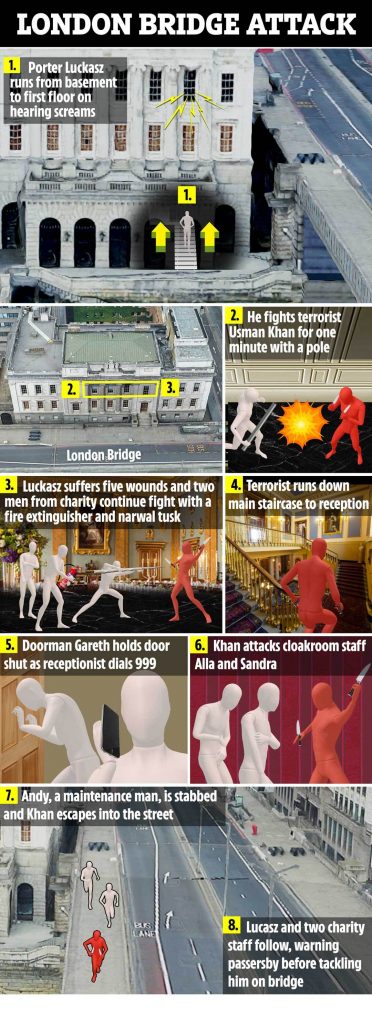 |
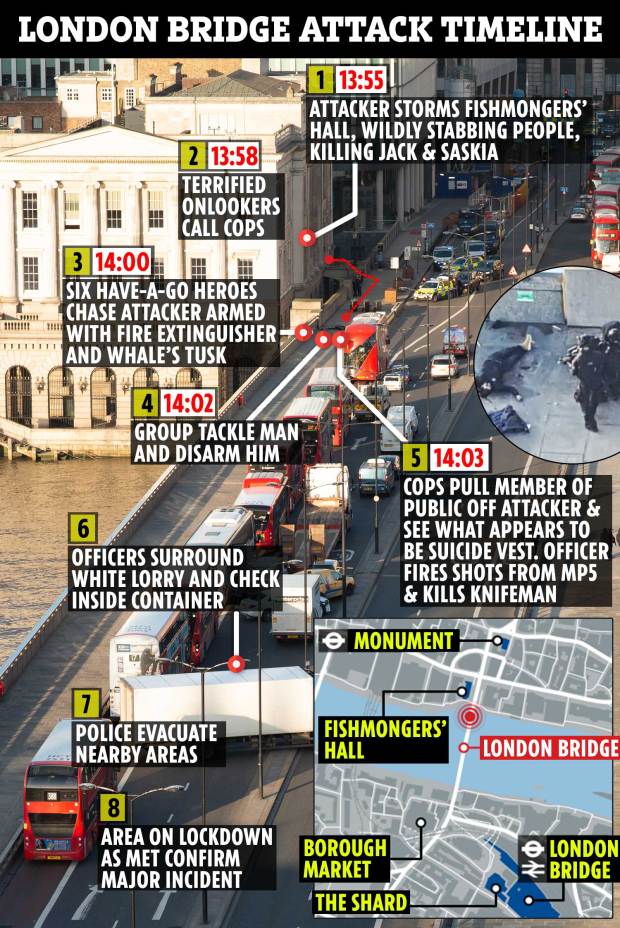 |




